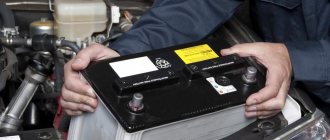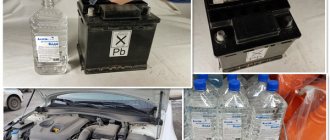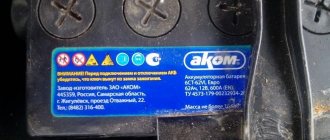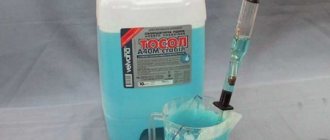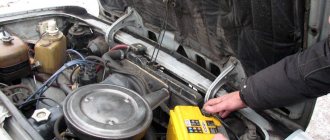Indispensable in a car, the starting battery has a certain service life. The operating principle of the device is based on the release of energy during an electrochemical reaction. The system is dynamic, the process depends on many factors. The duration of reliable operation of the battery can be extended or shortened by improper maintenance. How to choose a car battery and increase its life?
Planned service life of a car battery for write-off
The role of road transport in the transportation of goods and passengers can hardly be overestimated. But each vehicle is equipped with batteries of varying power. Battery life varies from car to car. Equipment in vehicle parks works intensively, but is under the supervision of specialists. Therefore, the battery service life for professionally operating vehicles is set depending on the mileage or operating hours.
Based on the standards, the service life of lead acid batteries is regulated by the standard RD-3112199-1089-02.
Private transport companies set vehicle battery life limits based on their own regulations. In personal cars, they try to use every opportunity to extend battery life.
Car battery service life according to GOST
Each standard, including GOST 959-2002 for lead-acid batteries, is developed taking into account the ingredients used and operating characteristics. The section “Reliability Requirements” prescribes: the shelf life of a battery not filled with electrolyte is 3 years, with electrolyte – 12 months.
The average service life of a car battery is determined when the capacity decreases from the original to below 40%. Another reason for the end of battery life is:
- For serviced batteries – 24 months with a mileage of up to 90,000 km, 12 months with a mileage of 150,000 km or 3,000 operating hours
- For maintenance-free batteries – 48 months, mileage up to 100,000 km or 4,000 operating hours
Imported batteries must be marked with the addition of the letter “T”
Leakage current
Third-party equipment, such as radios or alarms, if they are not connected correctly, can drain your battery, it doesn’t seem like a large leakage current, but for a couple of days, or even a week, and that’s it – a deep discharge! Therefore, if you notice that after parking for the night, the starter does not spin so quickly, it is worth measuring the leakage current . Then we fix it without fail, otherwise in a few months you will be buying a new battery.
Car battery lifespan
In practice, the battery operating cycle can be divided into 3 types - warranty, real and regulated. During the warranty, the manufacturer only eliminates proven manufacturing defects. With proper operation, the actual service life of a car battery can be significantly longer than the regulated one.
The warranty period for a new car battery ranges from 6 months to 4 years, depending on the manufacturer. A pattern has been noticed: the longer the manufacturer’s warranty, the longer the battery life. The shortest warranty period is provided by manufacturers of serviced batteries. But all factory defects are detected within the 6-month lifespan of the battery.
The actual life of a car battery depends not only on the mileage and operating hours.
- The structural resource is based on the amount of active mass, the alloy of the gratings, the quality of the electrolyte and adherence to technology. It is important that the battery arrives to the buyer “fresh”.
- The condition of the vehicle's on-board system, its energy saturation exceeding the capacity of the generator and the presence of leakage currents leads to chronic undercharging of the battery, which reduces its shelf life.
- A malfunction of the generator can lead to a deep drain on the battery, bringing the decommissioning date closer.
- Improper operation of the car in winter leads to freezing of the battery cans if the electrolyte has lost its density. The battery life may end here.
- Keeping the battery clean, measuring the voltage at the terminals during idle and operation, checking the electrolyte and timely mains charging will extend the battery life.
If used incorrectly, when the battery operates for a long time at a charge of about 60%, or is overcharged due to a faulty vehicle voltage regulator, sulfation occurs, the active mass is peeled off from the lead grid, and lead oxidation occurs. All this reduces the resource and average life of the battery.
If the car is used intensively in taxi mode, with short runs and long periods of downtime, the battery has a low charge and wears out faster. In order for the car to last for the regulated period, careful care of the battery is necessary.
What affects the use time?
But even calculations using the formula cannot guarantee that the battery will last exactly that long. Battery life is affected by:
- workmanship;
- serviced or maintenance-free battery;
- operating temperature;
- serviceability of the charging system;
- driving in the city cycle or outside the city;
- fastening;
- leakage current value;
- presence of mechanical influence;
- adjusting car electronic devices;
- condition of the plates;
- short circuit in banks.
What is the normal lifespan of a car battery?
The battery life specified by the manufacturer is based on normal vehicle use. Typically, an average battery lasts 3-4 years. Rated models can retain capacity for 6-7 years, but their cost is much higher.
Please note that you should not buy a car battery for future use; without regular use, its capacity decreases and self-discharge occurs.
It is believed that normal conditions have been created for the operation of the battery if the car is operated correctly:
- Without extreme temperatures - protected by insulation during downtime in winter, well ventilated and controlled in summer.
- Good maintenance involves keeping the battery in a clean, well-secured compartment. Loads are regularly measured, stray currents are detected, and the power supply unit is under control.
- The performance of the generator and the capacity of the battery are commensurate, the on-board systems - a computer, a stereo system, an air conditioner and others - correspond in terms of current consumption to the capabilities of the power system.
With good maintenance, the chosen driving style can be critical. During a short run, the battery does not charge. If, in addition, music is turned on during the idle period, the phone is recharging, the battery will receive a deep discharge, which will affect its service life. What kind of battery can withstand operating in constant deficit mode without consequences? There are no such.
During normal maintenance, the battery is considered new for the first 2 years. From the age of 3 in winter, it is necessary to strengthen control of the charge level before long periods of inactivity. If you do not comply with technical requirements, the life of a car battery can be reduced to a year or a year and a half.
How can I find out the release date and where can I see the manufacturing numbers?
Manufacturers always indicate the production date of the battery on the packaging, but the markings are different for each manufacturer, so you need to check with the seller , since determining the production date yourself will be problematic.
Advice. There are no standards for applying the production date to batteries, but in most cases, manufacturers indicate the production date in the form of a set of letters and numbers on the battery cover; you can check it on both the front and side labels.
In addition to consulting the seller, visiting the official website of the manufacturer can help decipher the date.
How to calculate?
On a working car, the battery life is determined by the mileage of the car and the operating time of the battery itself. The car's mileage is more than 100,000 km and the battery has been used for more than 3 years, which is a direct indication for replacing the battery. But these are general recommendations; with proper care, the battery can last much longer, which is why it is so important to calculate its operating time.
To determine the initial data required:
- Load power.
- Inverter efficiency.
- Battery voltage.
- Backup time.
- Lifetime.
The operating time is calculated using the formula:
t=Uacc. *C*K*H*Kr. /P where:
- t – operating time (for example, 5 hours);
- Ub. – battery voltage, (12V);
- C – capacity (Ah);
- K – number of batteries in the system (1 pc);
- N – inverter efficiency (0.82);
- Kr – discharge depth coefficient (80%);
- P – load power (150W).
We find the battery capacity C using the formula: C = P / Ubattery. * t / K / H / Kr , substituting the values, we get 150 / 12 x 5 / 1 / 0.82 / 0.8 = 95.3.
Selecting the right battery ensures that the battery discharge will not exceed 80%. Required shock frequency: 10 years x 365 days / 500 cycles = 7.3 days.
Battery operating time is measured in years and service life in operating cycles. The cycle is the time from full charge to discharge of the battery. The endurance of the battery in cycles is calculated for typical operating conditions (temperature 20°C, discharge with a current of the same value).
In this example, we find that under standard operating conditions, one cycle will take about 7 days (round the value to 7.3). We get a battery life of 10 years, provided that the cyclic resource is not exhausted earlier.
Extending battery life
There are posts on motorist forums where owners note that their batteries last 8-10 years. To extend the life of the device, you need a competent approach to the maintenance of the battery and car. The basic rule of experienced car enthusiasts is systematic monitoring of the voltage at the battery terminals. Six cells in series connection give a charge of 12.6 V. If the voltage is less than 12.5 V, the battery needs to be recharged. At the same time, measure and adjust the level and density of the electrolyte. Charge with a weak current of 1-2 A for 12-14 hours.
Rules that will help extend the life of your car battery:
- Do not try to start the car with a dead battery;
- if the engine does not start the first time, the next 3 attempts can be repeated at one-minute intervals;
- make it easier to start the engine in winter by giving a preliminary impulse to the battery - turning on the lights, fully pressing the clutch;
- systematically clean the battery, paying attention to the ventilation holes;
- When idle, disconnect all consumers.
These rules will help extend the life of car batteries. A prudent car enthusiast will not take risks. In winter, in the most severe frosts, it will keep the battery warm, ensuring trouble-free starting of the car engine in the morning. This is also the answer to extending battery life.
What is the average service life of a car battery from the date of manufacture?
Law “On Protection of Consumer Rights” in paragraph 1 of Art. 5 ruled that the service life of a product is the period of time from the date of its production until the moment after which it becomes unsuitable for subsequent use.
Advice. It is important to start using the battery no later than six months after it was released, since the ability to hold a charge decreases with increasing non-use time.
The service life of the battery depends on the following factors:
- terms of Use;
- number of charging cycles;
- active work or state of rest;
- battery characteristics;
- battery type.
Since the factors that determine the average life of a battery are quite numerous and broad, the time of use will vary in each specific case. What remains common is that the service life of the battery cannot be less than the warranty period established by the manufacturer.
Service life of gel car battery
The use of a gel starting battery is no longer uncommon. The excellent performance characteristics of the device are associated with the aggregate form of the electrolyte. The gel substance prevents leakage and fits tightly onto the plates, increasing energy production. The battery has a long charge-discharge cycle and a service life of 10-12 years. What is the battery self-discharge time? Approximately 20% per year. Even with deep discharge, the battery retains its structure and the plates do not fall off.
However, the gel battery life will be short under the following circumstances:
- the voltage in the vehicle's on-board network is more than 14.4 V;
- if the gel-like mass freezes, its properties are not restored, the electrolyte is sensitive to low temperatures;
- any short circuit will ruin the battery.
Each battery charge must be full, otherwise capacity loss occurs. The listed disadvantages and cost hinder the spread of gel car batteries.
Specifications
Before talking about the reasons for the significant time variation in operation, it is necessary to understand the features of the technical structure of most models. Since the advent of the first rechargeable batteries, there have been no major changes in the operating principle. Lead plates are placed inside the sealed housing. Their number depends on the purpose of the battery. Each section with a plate is sealed, but has an active surface.
The appearance of energy is ensured by negative and positive charge. Plates made of finely porous lead are negatively charged. Lead is immersed in a sulfuric acid electrolyte. It is he who interacts with the active substances of the plates. This chemical reaction produces an electric current. The battery is discharged due to the fact that lead sulfate precipitates, but during charging the entire process described occurs exactly the opposite. This allows high-quality batteries to last for many years.
Today, active development of new battery models is underway. Scientists are trying to increase energy intensity, reduce dimensions, and increase the service life of components. Some progress has already been achieved. For most modern cars and for batteries located under the hood, severe frosts are not terrible. Although just a few decades ago, low temperature was the worst enemy of an energy source.


